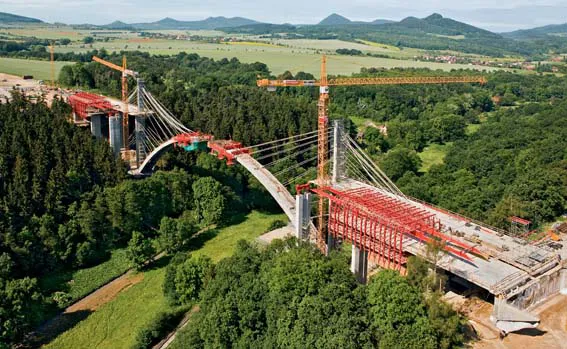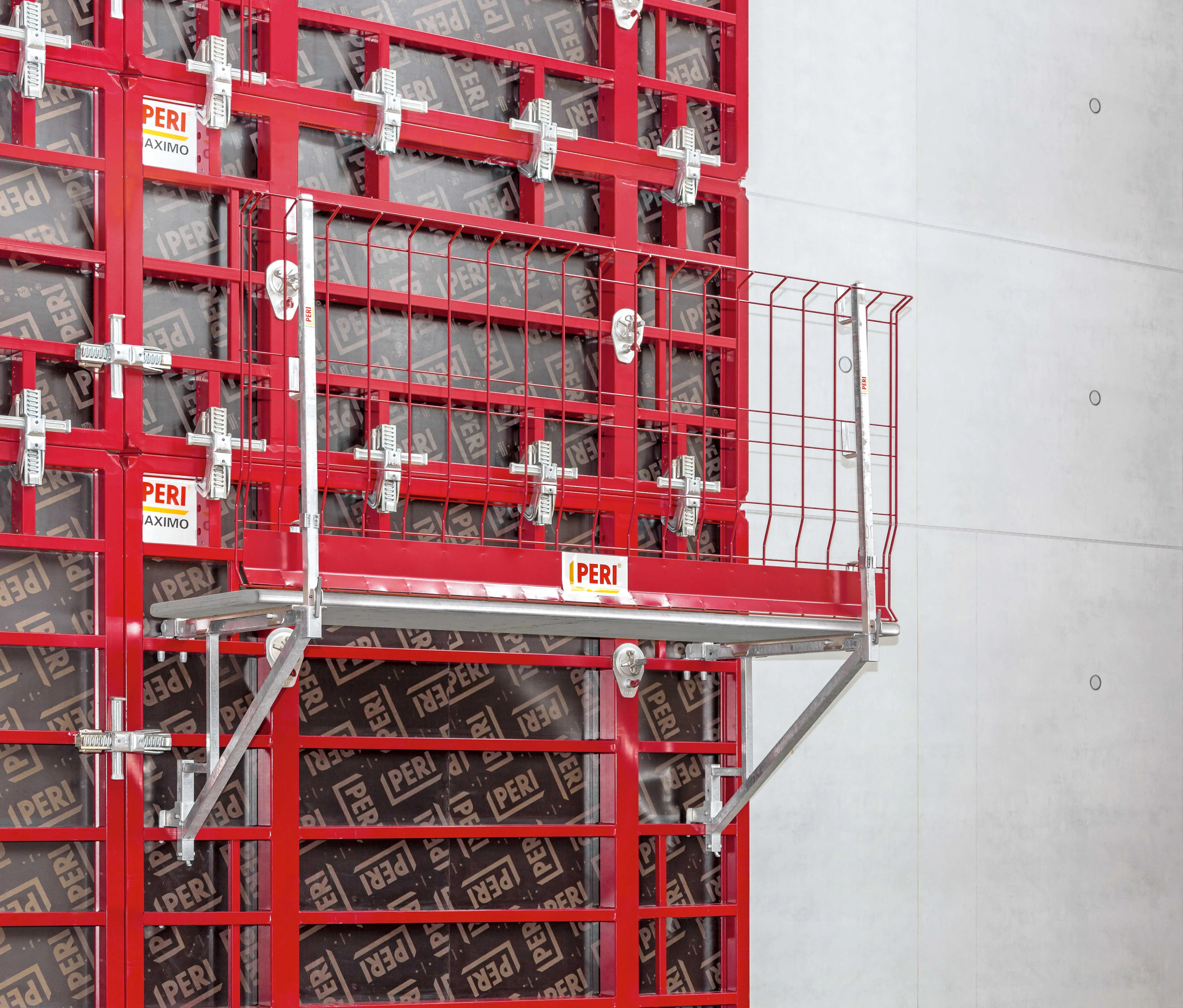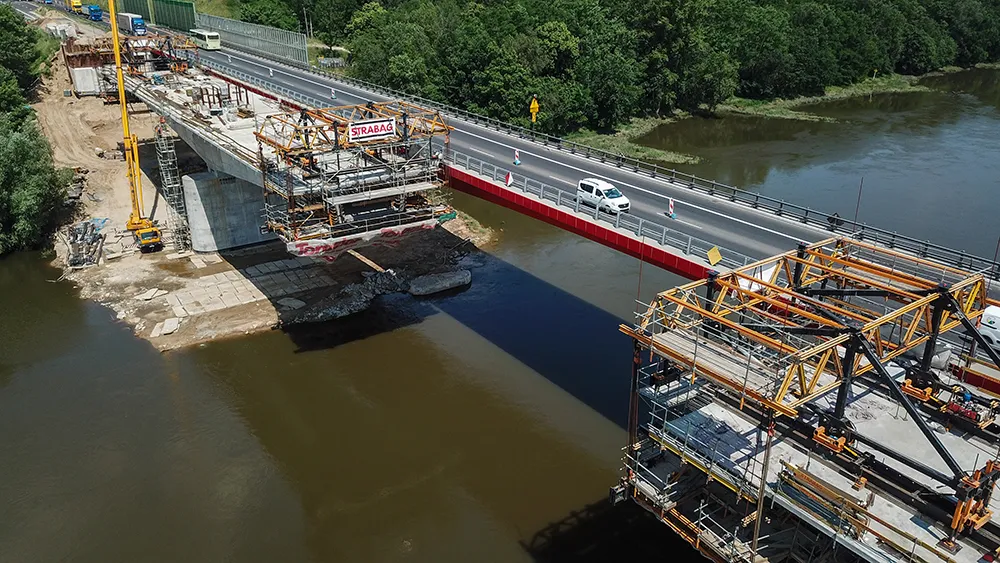For environmental reasons planners decided in favour of the challenging task of constructing a 13-field arched highway bridge over the Oparno Valley in the Bohemian area of the Czech Republic. The 258m bridge, whose reinforced concrete arch has a span of 135m, straddles the valley without any bridge piers, transferring the loads in the form of compressive forces into the foundations.
February 29, 2012
Read time: 3 mins

For environmental reasons planners decided in favour of the challenging task of constructing a 13-field arched highway bridge over the Oparno Valley in the Bohemian area of the Czech Republic.
The 258m bridge, whose reinforced concrete arch has a span of 135m, straddles the valley without any bridge piers, transferring the loads in the form of compressive forces into the foundations.
Known as the A17 in Germany and D8 in the Czech Republic, the highway connects Dresden and Prague. This in turn is part of the pan-European corridor which extends to Budapest (Hungary) and then on to Istanbul (Turkey). In the Bohemian Forest section alone, between Rehlovice and Lovosice, three interchanges, two tunnels and a total of 29 bridges are being constructed along the 16km route.
As most of the stretch of highway currently under construction passes through a landscape conservation area, special requirements due to strict environmental protection regulations have to be met by both the planners and contractor for the realisation of this particular highway section.
With the help of a comprehensive298 PERI formwork and scaffolding solution, two separate parallel structures are concurrently being constructed in both driving directions.
In close cooperation with the Prague-based building contractor Metrostav, PERI developed a cost-effective all-in-one solution using a standardised modular system with mostly rentable system components for the construction of the bridge elements. For the Oparno Bridge, the VARIOKIT engineering construction kit; RCS rail climbing system as well as PERI UP modular scaffold all played a key role. Construction of the supporting structures has been "very economical, optimally adapted to the individual project requirements."
The reinforced concrete arch is being constructed with the help of two customised formwork and scaffolding units in the form of a cantilevered construction. With this, the fresh concrete loads of the 5-6m long arched sections are transferred into the previously completed load-bearing sections.
During the moving procedure, hydraulic units provide the required lifting power so that work can be carried out without crane support, to a large extent, regardless of the weather.
The 53m formwork carriage and the formwork system itself are optimally configured to form a homogeneous supporting structure. For moving around the piers, the formwork is simply folded downwards. Mobile hydraulic pumps, which also ensure that the PERI RCS rail climbing system can operate crane-independently, allow the striking and shuttering procedures to take place.
The RCS rail climbing system for the erection of the bridge piers supplement the customised PERI modular system concept for the Oparno Bridge. The bridge piers are constructed in concreting cycle heights of between 3.1-3.6m with RCS climbing units. PERI UP stairs and access ladders as well as working platforms serve to allow personnel to reach and assemble the temporary bracing for the arched supporting structure.
The 258m bridge, whose reinforced concrete arch has a span of 135m, straddles the valley without any bridge piers, transferring the loads in the form of compressive forces into the foundations.
Known as the A17 in Germany and D8 in the Czech Republic, the highway connects Dresden and Prague. This in turn is part of the pan-European corridor which extends to Budapest (Hungary) and then on to Istanbul (Turkey). In the Bohemian Forest section alone, between Rehlovice and Lovosice, three interchanges, two tunnels and a total of 29 bridges are being constructed along the 16km route.
As most of the stretch of highway currently under construction passes through a landscape conservation area, special requirements due to strict environmental protection regulations have to be met by both the planners and contractor for the realisation of this particular highway section.
With the help of a comprehensive
In close cooperation with the Prague-based building contractor Metrostav, PERI developed a cost-effective all-in-one solution using a standardised modular system with mostly rentable system components for the construction of the bridge elements. For the Oparno Bridge, the VARIOKIT engineering construction kit; RCS rail climbing system as well as PERI UP modular scaffold all played a key role. Construction of the supporting structures has been "very economical, optimally adapted to the individual project requirements."
The reinforced concrete arch is being constructed with the help of two customised formwork and scaffolding units in the form of a cantilevered construction. With this, the fresh concrete loads of the 5-6m long arched sections are transferred into the previously completed load-bearing sections.
During the moving procedure, hydraulic units provide the required lifting power so that work can be carried out without crane support, to a large extent, regardless of the weather.
The 53m formwork carriage and the formwork system itself are optimally configured to form a homogeneous supporting structure. For moving around the piers, the formwork is simply folded downwards. Mobile hydraulic pumps, which also ensure that the PERI RCS rail climbing system can operate crane-independently, allow the striking and shuttering procedures to take place.
The RCS rail climbing system for the erection of the bridge piers supplement the customised PERI modular system concept for the Oparno Bridge. The bridge piers are constructed in concreting cycle heights of between 3.1-3.6m with RCS climbing units. PERI UP stairs and access ladders as well as working platforms serve to allow personnel to reach and assemble the temporary bracing for the arched supporting structure.









